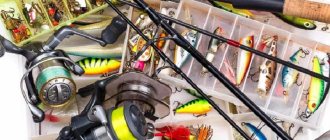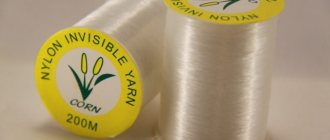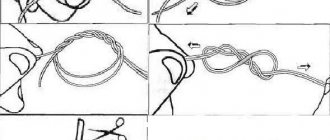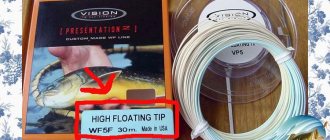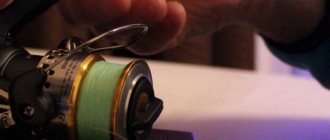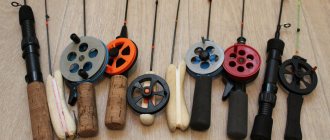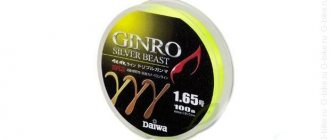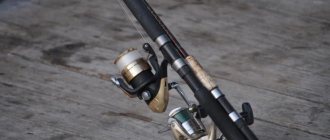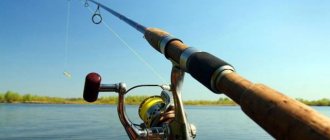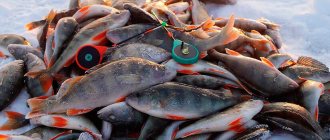Choosing the right one
To begin with, it should be noted that the fishing line occupies a separate place in a fisherman’s equipment, since it bears the main load when fishing and hooking. That is, with the help of a fishing line, contact is made between the fisherman and the fish. To catch a catch easily and without problems, you need to wisely choose the components of your fishing rod. For example, today fluorocarbon fishing line is popular, which has a number of features. But first, you should know about the basic properties of the fishing line, and the tackle for spinning must meet one requirement, and for bottom fishing - completely different.
Fluorocarbon: material features
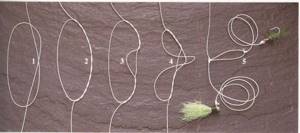
It should be noted that fluorocarbon line for leashes is used very often for many reasons. The material itself is durable and invisible in water. The latter characteristic depends on the fact that fluorocarbon has a low refractive index of light. Many people prefer to buy fluorocarbon-coated fishing line, which is cheaper and is an improved conventional nylon monofilament. Of course, this variety is cheaper, but it does not have all the properties of fluorocarbon fishing line. Its distinctive features include:
- invisibility in water: this quality is very important, because if the line is visible in the water, the fish will not take the bait - in feeder fishing, the line often sinks to the bottom, so it will be completely invisible;
- high elasticity: fluorocarbon fishing line does not bend or deform.
Flaws
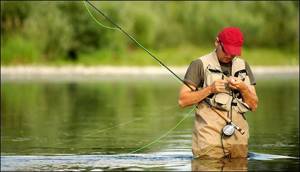
On the other hand, many note that this variety is less durable than monofilament, but if you choose a fishing line that is tensile, it can withstand even heavy loads. In addition, fluorescent tape is usually taken as a piece for a leash, so it is important that the leash be stronger. Strong knots for fluorocarbon fishing line play an important role. If they are not done correctly, the line will be difficult to attach to the rod. Therefore, experts advise using the strongest knots that will have many weaves.
Another disadvantage of invisible fishing line is its high cost. It is probably the most expensive of those on the market. True, a positive point can be found here: after all, fluorocarbon is used not as the main line, but in the leash, so you will need it at most three meters.
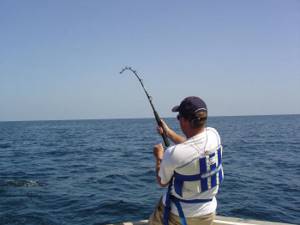
Which is the best fishing line for spinning?
When all the strengths and weaknesses of spinning lines have been clarified, you need to think about what kind of fish you will be hunting for, and also imagine the fishing conditions. Only with this approach will it be possible to make the most of all the best features of a spinning rod.
- The first thing you should do is inspect your rod and reel. If they are made of high-quality parts and have sufficient reliability, then a braided cord is suitable for equipment. Otherwise, it is better to choose monofilament or fluorocarbon line.
- Depending on the fishing technique, the thread is also selected. For jig fishing, braided line is the best option. It does not stretch, and any touch to the artificial bait will be clearly visible to the angler. However, for microjig it is more appropriate to use monofilament thread. This is explained by the fact that fishing is usually carried out over short distances. When casting close, the stretchability of the thread does not impair the sensitivity of the tackle.
- When catching such types of fish as chub, perch, ide, asp, nylon threads work quite successfully. But to pierce the mouth of a pike perch or pike, you need strong and inextensible braiding.
- When choosing a fishing line for a spinning rod, you should also take into account the size of the possible prey. So, to hunt for catfish, pike perch and pike weighing more than 5 kg, an angler will need braid. You can also engage in sport fishing for perch, chub or bersh with monofilament fishing line. When purchasing, you should pay attention to the maximum permissible weight of the fish, which is indicated on the packaging or drum with fishing line.
- The predator often sets up ambushes in thickets of grass or snags. In order not to leave your entire arsenal of baits underwater, it is better to install a spool with a braided cord on the reel. But for fishing in clear waters, monofilament or fluorocarbon is quite suitable.
A novice fisherman wants to buy one fishing line for all occasions. Only this can play a cruel joke at the most inopportune moment.
This is why experienced spinning anglers take 1-2 spare spools with them when fishing. Braid is wound on one of them, and the other is filled with monofilament fishing line. It is enough to spend 5 minutes to convert the spinning rod to the current conditions on a pond. Then the fish will be on the kukan, and the bait will remain unharmed in the box.
Which brand?
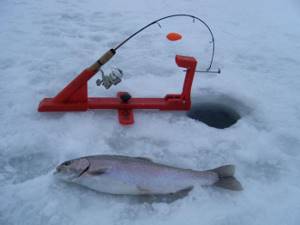
The most popular fluorocarbon fishing line for spinning rods is the Owner brand. Depending on the thickness of the fishing line, it can withstand a load of one to six kilograms. Loved by fishermen and developed jointly by German and Japanese scientists, Balzer fishing line. It has a high breaking load, and is not only made of 100% fluorocarbon, but also covered with it. And this guarantees that it will be invisible in water, resistant to abrasion and strong when tying knots. This brand of fishing line is ideal for any type of fishing and at any time of the year. Spinning, donka, bombard - fluorocarbon fishing line can be used for any of these types of fishing. The price for Balsax, for example, is 119 rubles per blister, the product for winter fishing Asseri Catalyx will cost approximately 170 rubles, and Lineaeffe, Akashi Fluorocarbon will cost approximately 156 rubles.
Nylon or fluorocarbon: pros and cons of fishing lines
The most popular materials from which monofilament filaments are made today are nylon and fluorocarbon. Tamaz Bochorishvili, a regular expert at the magazine “Fishing and Fish Farming,” compared the characteristics of these fishing lines and identified their pros and cons.
Modern fishing lines and cords are made exclusively from synthetic materials. The variety of fishing lines and cords is determined by different conditions, methods and, of course, fishing objects. With such a huge choice, the most popular is monofilament. And that's why:
● It is easy to use and versatile; ● There are many models of different diameters and colors; ● Suitable for different conditions and fishing objects; ● Affordable.
In our article we will talk about fishing line made of nylon and fluorocarbon. We will look at all the positive and negative properties of both materials. The term "nylon" is used to designate a family of synthetic polymers based on polyamides. Polyvinylidene fluoride (PVDF) is a fluorine-containing polymer belonging to the group of fluoroplastics.
Breaking load: needs to be considered as a whole
Let's compare fluorocarbon and nylon (copolymer) fishing lines of the same diameter. The label of the second indicates that it has a higher breaking load than the first. Is it so? At the beginning of use, it is indeed higher for nylon and copolymer fishing lines than for fluorocarbon fishing lines. But if you compare the same parameter after two weeks, it turns out that for PVDF it will remain unchanged, but for others it will decrease. The fact is that this parameter must be considered in combination with several factors: taking into account wear resistance, the penetration of water molecules into the crystalline structure of nylon and ultraviolet radiation, that is, those factors that affect strength.
Wear resistance and sensitivity: fluorine wins
Durability is a parameter that many anglers do not pay due attention to until they lose several expensive baits or trophy fish. The density of PVDF is 1.78 g/cm³, and that of conventional monofilament is 1.15 g/cm³. The density and hardness of fluorocarbon is higher than that of nylon, and therefore wear resistance.
Density determines the high sensitivity of the gear, since denser material better transmits the slightest touch to the bait. This can be easily tested using such a forgotten children's toy as a match phone: a thread was pulled through the holes in the centers of two boxes, secured on both sides with matches. One box served as a “microphone” and the second as a “speaker”. The sound was transmitted over a distance due to the vibration of the thread.
If instead of a thread you pull both materials in turn, then the sound of PVDF will be louder. This indicates better resonance and therefore higher sensitivity. Plus, fluor fishing line is less susceptible to abrasion and thinning, which also has a positive effect on its strength.
Extensibility: depends on the situation
Extensibility is one of the important characteristics of fishing line. It can be divided into two phases: elasticity and plasticity. Elasticity is the ability of a material to immediately return to its original state after being released from load or deformation. Most often, this characteristic has a linear relationship: as the deformation increases, the percentage of elongation increases proportionally.
Most materials, after reaching a certain level of deformation, cannot return to the original length after removing the load, that is, tension goes into the plastic phase. In a certain situation, extensibility can have positive properties, in others it can have negative properties. For high-quality fishing lines, the parameter can vary from 15 to 25% of the working length of the monofilament. When catching fast and strong fish, it is very important that the fishing line can cushion and not tear, but dampen the gusts of the fish. Monofilament nylon in this option will be preferable to fluor.
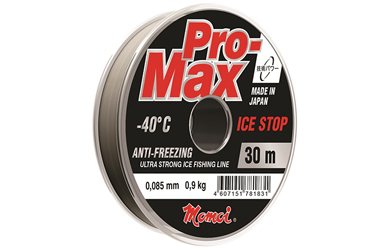
Fluorocarbon has lower elongation than equivalent nylon. Many anglers believe that the fly has little stretch. According to manufacturers, PVDF, on the contrary, stretches more than nylon, but requires more significant effort. The low stretch of fluorocarbon provides better contact and controllability of the bait.
Water permeability: nylon lags behind
Water permeability is another factor affecting breaking load. Fluorocarbon does not absorb water, and nylon has low resistance to liquid penetration. Nylon swells when exposed to water molecules. On the good side, nylon line, which slightly absorbs water, is softer and easier to handle. On the negative side, water absorption weakens the line, increases elongation and reduces strength. If you compare dry and wet nylon, you will immediately notice the difference in elongation when stretched. A wet thread, relatively dry and depending on the time spent in water, can stretch 12.5% more and at the same time can lose up to 10% of its strength in a few hours.
Water permeability affects the nodal strength and breaking load of the fishing line. For example, we will tie a simple double knot from both materials in wet and dry form. In each option, we will conduct several tests on the same monofilament diameter. In “dry” tests, nylon retains 97% strength, and fluor only 77%. When nylon is wet and swollen, the strength drops to 83%, while fluorocarbon remains at 77%. These indicators largely depend on the quality of the monofilament, the type of knot used and the angler’s ability to tie knots correctly. The type of knot should always be selected for a specific fishing line and cord, regardless of the material.
Why choose fluorocarbon?
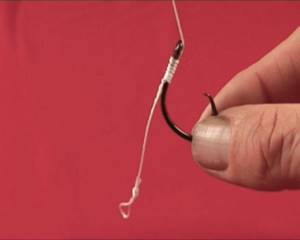
The main difference that characterizes fluorocarbon fishing line is the index of light refraction. The second advantage compared to conventional fishing line is its resistance to external irritants, that is, sunlight, ambient temperature. No matter what conditions the product is used, it will retain its strength and invisibility. In addition, such fishing line is not afraid of temperature changes. Another advantage is resistance to stretching and abrasion even with prolonged use. Tying perfectly into any type of knot, the product holds its shape well and remains invisible to fish in any conditions. Even if the fishing line is in water for too long, it will not absorb moisture, swell or change shape.
What is fluorocarbon line
Fluorocarbon fishing line is made from fluoropolymer fiber, consisting of carbon and fluorine. Characterized by high resistance to solvents and acids. It began to be used as insulators in wiring, film in capacitors, and a fishing line from it was randomly made in the Japanese Kureha corporation.
Other properties of this polymer are that it is crystalline in structure, has high density and has strong piezoelectric properties.
These three properties explain why fluorocarbon line is stiffer than nylon lines and is brittle compared to nylon.
It deforms and weakens when stretched, breaks when bent.
Strength is provided only by the outer shell.
The properties of fluorocarbon are more similar to glass.
Fluorocarbon fishing line: user reviews
As you know, products from different brands and manufacturers can differ significantly from each other. For example, many users say that if low-quality fluorocarbon was used to create the fishing line, then the final product will be unreliable in operation. The technology and equipment used, as well as the perfection of the fishing line design, also play a big role. Fishermen speak well of Kureha brand fishing line, which, according to them, is one of the most reliable and durable. The secret of these characteristics is that for its production two types of raw materials and only modern technologies are used. As a result, the fishing line is simultaneously soft, elastic, and very durable.
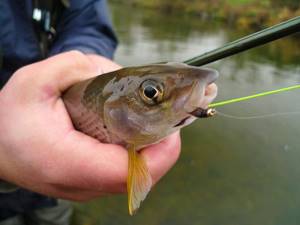
Winter fluorocarbon fishing line DeLUX Fluoro Carbon is described on the packaging as very reliable and tear-resistant. But in reality it turns out that the calibration differs from the stated figures, the diameter of the fishing line also varies, and it does not withstand knots with a large number of bends very well. Cottus Fluorocarbon brand products are good and reliable in operation, since they are made of PVDF, that is, fluorocarbon in accordance with Japanese technology. At the knots the line is quite strong, and does not lose strength even with many bends.
Little can be learned about the Salmo Fluorocarbon fishing line from the packaging, but in fact it turns out that its diameter is smaller than stated, and in terms of breaking load it is significantly inferior to its analogues. But in terms of components, the product is of excellent quality, so it can be used for lead equipment, for fishing with a feeder, and for a regular float rod. All three brands will cost an average of 150-170 rubles per 100 meters.
Types of spinning lines
Spinning lines differ from each other in the following parameters:
- thickness;
- color;
- breaking capacity;
- manufacturing material.
Today, with equal success, a beginning spinning player can use three types of threads:
- monofilament;
- braided cord;
- fluorocarbon thread.
Each of these types has both positive sides and disadvantages. But for each specific fishing trip, one of these options will look more profitable.
Monofilament
Traditionally, spinning tackle was equipped with monofilament lines. They have exceptional smoothness, which allows the thread to slide through the guides of the rod with minimal friction. Thanks to this property, the spinning angler can cast baits of different shapes and weights far.
The monofilament has little resistance to the flow of water, as a result of which light baits can be placed at the very bottom. The fishing line does not form windage in the water layer, so spinners and wobblers do not tend to float to the surface.
The advantages of monofilament in this aspect become especially noticeable when fishing with a spinning rod with a test load within 5 g.
The main advantages of monofilament are:
- minimal friction;
- low resistance in water;
- good stretchability;
- visibility or invisibility at the request of the fisherman;
- affordable price.
Among the main disadvantages of monofilament fiber, experts note:
- insufficient strength;
- stretchability in case of jig fishing.
For those fishermen who continue to equip their spinning rod with an inertial reel without a friction brake, monofilament fishing line will become a lifesaver in the fight against a trophy predator.
Braided cord
Not long ago, braided fishing line appeared on the domestic market of fishing accessories. And immediately legends began to circulate among spinning anglers about the capabilities of this new product.
This type of fishing line is a fiber consisting of several very thin threads. They are intertwined in a special way, forming a strong cord.
With a thickness similar to monofilament, the braid is much stronger. The cord has zero elongation. This property allows you to make the tackle very sensitive.
Even at a great distance, the bite will be clearly transmitted to the rod.
Domestic spinning players liked the braided cord for the following qualities:
- maximum strength;
- lack of extensibility;
- durability with proper use;
- unpretentiousness of the cord in operation and storage.
Braid also has some disadvantages. Among them it is worth highlighting:
- high cost of the cord;
- ruffling of fibers when fishing on a rocky area or in snags;
- the need to have a high-quality reel and perfectly smooth guide rings.
As for the high cost of braided fishing line, if you visit a pond frequently, the cord quickly pays for itself. If regular monofilament wears out within 1 season, then braided thread can last 2-3 years. Due to its high strength, such a cord allows you to preserve baits with a dead hook, unbending the hooks on spinners or wobblers.
If a novice spinning fisher has an irresistible desire to buy braided line, you should pay attention to the quality of the guide rings in the rod. Only silicon carbide (SiC) inserts can withstand the friction of a braided cord. Passage rings made of low-quality material are quickly frayed by braid.
Fluorocarbon thread
In terms of popularity among spinners, fluorocarbon fishing line is significantly inferior to its nylon and braided competitors. However, the unique properties of this material can be successfully used in spinning fishing.
The main advantage of fluorocarbon is its invisibility in water. For example, monofilament fishing line has a refractive index of 1.33. At the same time, for fluorocarbon thread this parameter is within 1.42. Thanks to this property, the fishing line is practically invisible in the water.
The weakness of fluorocarbon is its low tensile strength. With the same thickness, this type of fishing line breaks more easily than monofilament or braided line.
It is worth highlighting several important advantages of fluorocarbon thread:
- The material sinks quickly in water, which gives the spinner an advantage in strong winds.
- The line is extremely resistant to abrasion on shell rock, stones or driftwood.
- Fluorocarbon has zero elongation.
- The fishing line does not absorb water.
- Thanks to its resistance to low temperatures, this thread allows you to fish until the freeze-up.
Externally, monofilament fishing line is quite similar to fluorocarbon, which is often used by unscrupulous sellers. In this regard, the angler should know a simple way to recognize this material. It is enough to bring a burning lighter to the tip of the fishing line and observe its behavior. If the fishing line melts, curling up into a colorless lump, then it is a regular monofilament thread. When the material chars into a black ball, you can be sure it is fluorocarbon.
Premium fishing line
There are also brands that are considered premium. For example, Shade is quite popular among fishermen, although it is significantly more expensive than its analogues. On the other hand, when buying such a fishing line, you don’t have to worry about the technical properties of the product. In this fishing line, all declared indicators correspond to what it shows during operation. The fishing line is soft, so it is ideal for fishing with a float rod or feeder: with the help of such a product, the bait will be presented neatly and unnoticed by the bait, and accordingly, the chances of a good bite are high. True, such a fishing line costs 250 rubles for 50 meters.
The Sunline Siglon FC brand is also quite popular among buyers, and the characteristics of the fishing line are quite sufficient for amateur fishing. True, its diameter differs slightly from what is indicated on the packaging, and the breaking load is also slightly reduced. In accordance with these indicators, such fluorocarbon fishing line is best used for simple knots. But at the same time, the properties of the material are quite sufficient to use it for fishing both with a spinning rod and using natural baits.
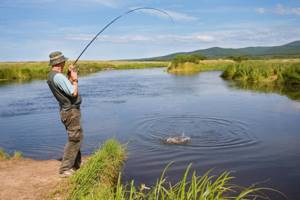
Many anglers believe that using fluorocarbon products you can even catch pike. As an explanation, they argue that thanks to such a leash, the bite becomes much greater, and the leashes are not broken even by a predatory pike. But in any case, when choosing a fishing line, pay attention to how resistant it is to stretching and pressure, how tensile strength it is, and whether it absorbs moisture. Taking these characteristics into account will allow you to choose a good fishing line and thereby ensure successful fishing.
Diameter
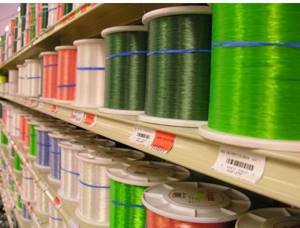
There are also several versions regarding the thickness of the fishing line for pike, but most spinners believe that the fishing line for a predator should be both strong and thin - at the same time.
Here it is necessary to understand that spinning fishing, unlike fishing with a float tackle, where a thin thread is used as one of the equipment elements (increases the number of bites), has its own nuances: the object of fishing does not pay attention to the fishing line, and when it sees the bait it likes, it immediately grabs it sharp teeth. Therefore, the strength of the thread should be maximum.
The diameter of the fishing line plays a significant role when casting bait over long distances, in particular when using an inertia-free reel.
The rule for choosing a thread: a thin and strong fishing line can ensure the coordinated operation of a sensitive rod and an easily adjustable reel.
It is recommended to choose the thickness of the fishing line in accordance with the weight of the bait and the type of reel:
- A cross section of 0.35 - 0.4 mm is ideal for inertial coils.
- A cross section of 0.25 - 0.27 mm can be used for inertia-free models.
An important point: frequent casting wears out the fishing thread; it is more rational to use the same version of the product, but of domestic production. Another economical option is to rewind the fishing line with the other end after the next fishing, then remove it completely and put in a new one.
